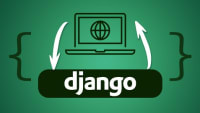Description
In this course, you will learn:-
- Construct a Django blog
- Learn how to integrate Markdown with Django
- RESTful API Design with Django Rest Framework
Syllabus:-
- Welcome
- Software Versions
- On YouTube
- System Setup
- System Setup Links (PDF)
- 1 page
- Introduction
- Walkthrough
- Before Getting Started
- Versions & Install
- First App & Model
- CRUD
- Writing our First View
- Request & Response
- Mapping URLs to Views
- In App URLs
- Django Templates
- Template Context
- QuerySet Basics
- Get Item or 404 Query
- Dynamic URL Routing & Patterns
- URL links & Get Absolute URL
- Model Form & Create View
- Instance Update View
- Django Messages Framework
- Delete View
- Template & Inheritance
- Setup Static Files - CSS & Javascript & Images in Django
- Implement Bootstrap
- Pagination by QuerySet
- File Uploads with FileField and ImageField
- SlugField
- Social Share LInks
- Custom Template Tags
- Basic User Permissions
- Associate User to Post with a Foreign Key
- Using Facebook Comments
- Item Publish Data & Draft
- Model Managers & Handling Drafts
- Search Posts
- Next Steps & Thank you
- Welcome to Advancing the Blog
- Blog from Try Django 1.9
- Render HTML and Markdown
- Implement Django Pagedown for Stack Overflow Style Markdown
- Responsive Image inside of Post Markdown Content
- Render Markdown & Django
- Truncate and Django Template Tags
- Dynamic Preview of Form Data
- Django Crispy Forms
- Bootstrap Input Groups
- Django Generic Foreign Keys Part 1
- Django Generic Foreign Keys Part 2
- Django Generic Foreign Keys Part 3
- Model Managers & Instance Methods
- Create Comments
- Reply to Comments
- jQuery fadeToggle for Comment Replies
- Comment Thread
- Count Words & Get Read Time with Python
- Blog Post Read Time in Django
- Delete View with Confirmation
- Delete Permissions & Http Status Codes
- Basic User Login, Registration, and Logout
- User Login & Form Validation
- User Register Form & View
- User Login Required
- Breadcrumb Navigation
- Thank you!
- Welcome
- Getting Started & Installations
- API Module & ListAPIView
- Serialize Model Data into JSON
- Serializing Objects in the Python Shell
- Retrieve API View aka Detail View
- Update & Destroy (Delete) API View
- Update & Delete in the Python Shell
- Create Serializer and Create API View
- Associate User with View Methods
- Custom Permissions
- Filtering a QuerySet in a ListAPIView
- Pagination with Rest Framework
- Hyperlinked Identity Field for URL
- Serializer Method Field
- Comments API
- Comment Children & Reply Count
- Comments in Post Detail API View
- Comment Create Serializer Function Part 1
- Comment Create Serializer Function Part 2
- Comment Create Serializer Function Part 3
- Update & Destroy Mixins
- Comment Detail, Update, & Delete
- Comment URLS & Post GET API Urls
- User API Setup
- ModelSerializer Create Method
- Serializer Validation
- Base APIView for User Login
- UserLogin API Validation
- User Detail Serializer
- Django Rest Framework Settings
- Django Rest Framework JWT & Curl Tests
- Thank you!
- 1- Introduction
- Start Project
- First Migration
- Apps
- First View & Url Routing
- Django Settings Overview
- Template Configuration
- Models
- Model Form
- Form Validation
- View & Template Context
- Form in a View
- Custom Form in a View
- Setup Email
- Static Files in Django 1.8
- Serving Static Files
- Adding Bootstrap to Django
- Django Templates
- Third Party Library: Django Crispy Forms
- Bootstrap Grid System
- Styling MVP Landing Part 1
- CSS with Blocks
- URL Names as Links
- Styling MVP Landing Part 2
- Django Registration Redux
- Update Django Login URL to Custom URL
- Authentication Links in Navbar
- Login Form in Bootstrap Navbar
- Styling MVP Landing Part 3
- Logo Image in Navbar
- Promo Video & Images
- Icons with Font Awesome
- Content for Authenticated Users
- QuerySet Basics
- Settings for Different Environments
- Using SSH for with Webfaction Secure Shell
- FTP for Production Settings
- Install PIP + Migrate + Static Settings
- Fix Static Settings
- Final One









